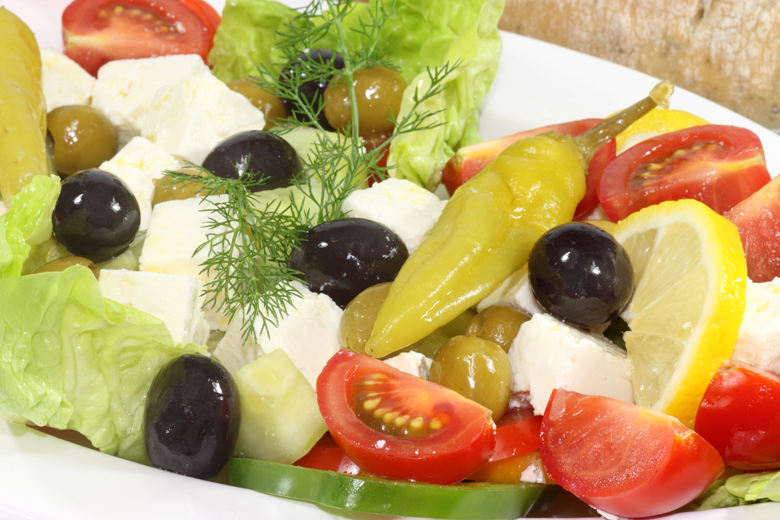
Greek Village Salad
The Greek salad, or “Horiatiki Salata,” has roots in ancient Mediterranean cuisine, though its exact origin remains unclear. Emerging in the early 20th century, it became a staple dish in Greek households and restaurants, particularly in rural areas abundant with fresh produce. Its ingredients, including tomatoes, cucumbers, onions, bell peppers, olives, and feta cheese, reflect Greece’s agricultural landscape. Feta cheese, with its tangy flavour and crumbly texture, is a quintessential element of Greek salad.
 Seasoned with dried oregano and dressed with extra virgin olive oil and red wine vinegar, it enhances the natural taste of the ingredients. Greek salad holds cultural significance, symbolizing Greek hospitality and culture. It’s commonly served as a starter or side dish in Greek meals and enjoyed year-round, especially during the summer months. Its popularity extends globally, found on menus in Greek restaurants worldwide, appreciated for its simplicity, vibrant colours, and fresh flavours.
Seasoned with dried oregano and dressed with extra virgin olive oil and red wine vinegar, it enhances the natural taste of the ingredients. Greek salad holds cultural significance, symbolizing Greek hospitality and culture. It’s commonly served as a starter or side dish in Greek meals and enjoyed year-round, especially during the summer months. Its popularity extends globally, found on menus in Greek restaurants worldwide, appreciated for its simplicity, vibrant colours, and fresh flavours.
Furthermore, variations of Greek salad may include additional ingredients such as pickled chillies, which add a spicy kick to the dish, enhancing its complexity and appeal. Overall, Greek salad epitomizes the Mediterranean diet, emphasizing fresh, seasonal ingredients and the importance of olive oil in culinary traditions. Its enduring appeal lies in its ability to evoke the sunny flavours and warmth of Greece, making it a beloved dish enjoyed by many across different cultures.
- Calories: 373
- Fat: 29 grams
- Saturated fat: 9 grams
- Unsaturated fat: 18 grams
- Trans fat: 0 grams
- Carbohydrates: 19 grams
- Sugar: 10 grams
- Sodium: 837 mg
- Fiber: 5 grams
- Protein: 10 grams
- Cholesterol: 45 mg

- 4 large ripe tomatoes, cut into wedges
- 1 large cucumber, peeled and sliced
- 1 red onion, thinly sliced
- 1 green bell pepper, sliced
- ½ cup Kalamata olives, pitted
- 200g feta cheese, crumbled
- ¼ cup extra virgin olive oil
- 2 tablespoons red wine vinegar
- 1 teaspoon dried oregano
- Salt and freshly ground black pepper to taste
- Pickled chilies, to taste (sliced)
- Prepare the Vegetables: Wash and cut the tomatoes into wedges. Peel the cucumber and slice it. Thinly slice the red onion. Slice the green bell pepper. Place all the vegetables in a large salad bowl.
- Add the Olives, Feta, and Pickled Chilies: Add the Kalamata olives to the salad bowl. Crumble the feta cheese over the top of the vegetables. Slice the pickled chilies and add them to the salad bowl.
- Make the Dressing: In a small bowl, whisk together the extra virgin olive oil, red wine vinegar, dried oregano, salt, and black pepper until well combined.
- Dress the Salad: Drizzle the dressing over the salad ingredients in the bowl.
- Toss Gently: Gently toss all the ingredients together until the vegetables are evenly coated with the dressing and the feta cheese is distributed throughout.
- Chill (Optional): If desired, cover the salad bowl with plastic wrap and refrigerate for about 30 minutes to allow the flavors to meld together.
- Serve: Serve the Greek salad chilled or at room temperature as a side dish or light meal. Enjoy the added zing from the pickled chilies!
